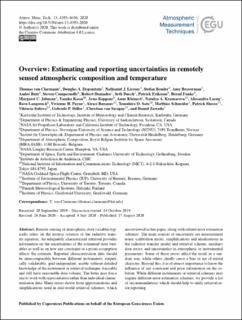| dc.contributor.author | von Clarmann, Thomas | |
| dc.contributor.author | Degenstein, Doug A. | |
| dc.contributor.author | Livsey, Nathaniel J | |
| dc.contributor.author | Bender, Stefan | |
| dc.contributor.author | Braverman, Amy | |
| dc.contributor.author | Butz, André | |
| dc.contributor.author | Compernolle, Steven | |
| dc.contributor.author | Damadeo, Robert | |
| dc.contributor.author | Dueck, Seth | |
| dc.contributor.author | Eriksson, Patrick | |
| dc.contributor.author | Funke, Bernd | |
| dc.contributor.author | Johnson, Margaret C | |
| dc.contributor.author | Kasai, Yasuko | |
| dc.contributor.author | Keppens, Arno | |
| dc.contributor.author | Kleinert, Anne | |
| dc.contributor.author | Kramarova, Natalya | |
| dc.contributor.author | Laeng, Alexandra | |
| dc.contributor.author | Payne, Vivienne H | |
| dc.contributor.author | Rozanov, Alexei | |
| dc.contributor.author | Sato, Tomohiro O | |
| dc.contributor.author | Schneider, Matthias | |
| dc.contributor.author | Sheese, Patrick | |
| dc.contributor.author | Sofieva, Viktoria | |
| dc.contributor.author | Stiller, Gabriele P | |
| dc.contributor.author | von Savigny, Christian H.P. | |
| dc.contributor.author | Zawada, Daniel | |
| dc.date.accessioned | 2020-08-18T11:20:44Z | |
| dc.date.available | 2020-08-18T11:20:44Z | |
| dc.date.created | 2020-08-12T11:45:21Z | |
| dc.date.issued | 2020 | |
| dc.identifier.citation | Atmospheric Measurement Techniques. 2020, 13 4393-4436. | en_US |
| dc.identifier.issn | 1867-1381 | |
| dc.identifier.uri | https://hdl.handle.net/11250/2672797 | |
| dc.description.abstract | Remote sensing of atmospheric state variables typically relies on the inverse solution of the radiative transfer equation. An adequately characterized retrieval provides information on the uncertainties of the estimated state variables as well as on how any constraint or a priori assumption affects the estimate. Reported characterization data should be intercomparable between different instruments, empirically validatable, grid-independent, usable without detailed knowledge of the instrument or retrieval technique, traceable and still have reasonable data volume. The latter may force one to work with representative rather than individual characterization data. Many errors derive from approximations and simplifications used in real-world retrieval schemes, which are reviewed in this paper, along with related error estimation schemes. The main sources of uncertainty are measurement noise, calibration errors, simplifications and idealizations in the radiative transfer model and retrieval scheme, auxiliary data errors, and uncertainties in atmospheric or instrumental parameters. Some of these errors affect the result in a random way, while others chiefly cause a bias or are of mixed character. Beyond this, it is of utmost importance to know the influence of any constraint and prior information on the solution. While different instruments or retrieval schemes may require different error estimation schemes, we provide a list of recommendations which should help to unify retrieval error reporting. | en_US |
| dc.language.iso | eng | en_US |
| dc.publisher | European Geosciences Union | en_US |
| dc.relation.uri | https://amt.copernicus.org/articles/13/4393/2020/ | |
| dc.rights | Navngivelse 4.0 Internasjonal | * |
| dc.rights.uri | http://creativecommons.org/licenses/by/4.0/deed.no | * |
| dc.title | Estimating and Reporting Uncertainties in Remotely Sensed Atmospheric Composition and Temperature | en_US |
| dc.type | Peer reviewed | en_US |
| dc.type | Journal article | en_US |
| dc.description.version | publishedVersion | en_US |
| dc.source.pagenumber | 4393-4436 | en_US |
| dc.source.volume | 13 | en_US |
| dc.source.journal | Atmospheric Measurement Techniques | en_US |
| dc.identifier.doi | 10.5194/amt-13-4393-2020 | |
| dc.identifier.cristin | 1822960 | |
| dc.relation.project | Norges forskningsråd: 223252/F50 | en_US |
| dc.description.localcode | © Author(s) 2020. This work is distributed under the Creative Commons Attribution 4.0 License | en_US |
| cristin.ispublished | true | |
| cristin.fulltext | original | |
| cristin.qualitycode | 1 | |

